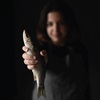Cooking with Cape Hake is always an absolute pleasure. It's a fish that is as sustainable as it is delicious, which means that future generations will get to enjoy everyone's favourite seafood!

Prep time
10 mins
Cooking Time
20 mins
Serves
8
Ingredients
- 2kg MSC certified Cape hake, cleaned and cut into sections
- Olive oil, for frying
- 2 onions, peeled and sliced into rings
- 2 cups white wine vinegar
- 125ml water
- 75ml white sugar
- 3 bay leaves (fresh or dried)
- 10ml ground turmeric
- 10ml cumin seeds
- 10ml garam masala powder
- 10ml coriander seeds
- 10ml black peppercorns
- 1 heaped tablespoon cake flour
- 10ml salt
Method
- Fry the hake sections in olive oil until just cooked through. Season the fish with salt and pepper and set aside.
- Fry the onions in a little olive oil until just cooked – you want them to still have a crunch.
- In a saucepan, combine the vinegar, water, sugar, bay leaves, spices, salt and peppercorns and simmer for 10 to 12 minutes. Use a little of the sauce combined with the flour to make a roux. Thicken the sauce and add in the fried onions.
- Use boiling water to sterilize a few jars or one large container. Place the hake sections into the jars and spoon over the onions and sauce, taking care to entirely cover each piece of fish.
- Refrigerate the pickled fish and serve after a minimum of three days. The fish will keep in a sealed jar in the fridge for up to 6 months.


